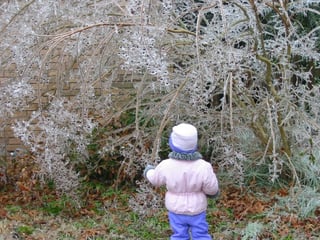 Escape the Winter Doldrums with Homeschool Science
Escape the Winter Doldrums with Homeschool Science
January and February can be hard on homeschooling morale. I want to break up the monotony of long winter days, but I don’t want to lose speed intellectually, when we’re just getting back on track after the holidays. My favorite solution: Make hands-on science the go-to subject for escaping the winter doldrums.
Here are some field-tested ideas to get you started:
Harness the educational powers of ice and cold. Every winter I recommend Walter Wick’s gorgeous collection of classic science experiments, A Drop of Water. The photographs alone are a study in fine art, and the experiments with frost, ice, and snow are perfect for winter weather. I borrow my public library’s copy, though I’d love to have this book on the shelves at home – it fascinates the whole family, from preschool through adults.
Watch birds. For those of us in southern states, winter is when we get to meet all the birds that summer farther north. My favorite guidebooks are the Peterson Field Guides (I have Birds of Eastern and Central North America, 5th Edition, by Roger Tory Peterson), but I recommend you borrow a selection of guidebooks from your public library first, and choose the one you find easiest to use. One good guide book, a bird feeder, and a supply of sunflower seeds, has kept our family interested in bird-watching for over a decade now.
For purchasing locally-based field guides, check out the bookshop at the nearest state or national park, next time your travels take you in that direction. For sketching in a nature journal, my children have been taking advantage of the various “how to draw animals” books from our public library. The student can draw or trace the basic “bird” image, then give it the beak shape and feather coloring of the bird out at the feeder.
Open a science lab. I’m married to an engineer who collects laboratory equipment, so we have a background level of science activity going on in the house at all times. But if you’re daunted by the prospect of science experiments, take a look at the Stratton House kits:
http://www.homeschoolscience.com/homeschool_science/curriculum.html
I have not used these kits myself, but they come well-recommended by Pat Dixon, a longtime homeschooler, lotsa-mom, and Mother of Divine Grace homeschool consultant. Her endorsement: “definitely the best elementary science program I've ever seen.” The consensus among reviewers is that these are well-suited for families who want to do hands-on science, but need a kit with all the supplies and lessons ready to go in a single package.
Play with electricity. Several years ago, my son received a small snap-circuit kit for Christmas. (http://www.snapcircuits.net/). These kits are great for about 4th grade and up – the student needs to be a strong reader in order to follow the directions-- and you only need to purchase one basic kit. All the kids can use the same kit year after year. We have the best luck if we let just one child work on a project at a time – electricity and sibling rivalry don’t mesh well. I love the way these kits let any child be “the science kid”, without having to have a particular talent for science. You just follow the directions, and are rewarded with an interesting project that really works.
Your turn: What tips do you have for breaking up a grey winter school day? Do you have a favorite science activity? Do you like to change up the routine with a different fun subject? Or do you find it works best to just keep plugging through the regular curriculum, and defeat the doldrums some other way altogether?
Copyright 2013 Jennifer Fitz
About the Author

Guest
We welcome guest contributors who graciously volunteer their writing for our readers. Please support our guest writers by visiting their sites, purchasing their work, and leaving comments to thank them for sharing their gifts here on CatholicMom.com. To inquire about serving as a guest contributor, contact editor@CatholicMom.com.


.png?width=1806&height=731&name=CatholicMom_hcfm_logo1_pos_871c_2728c%20(002).png)
Comments